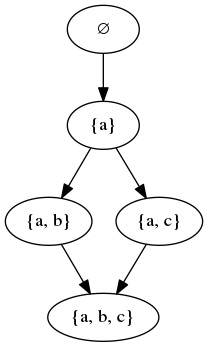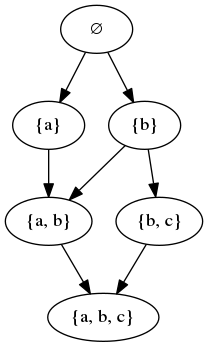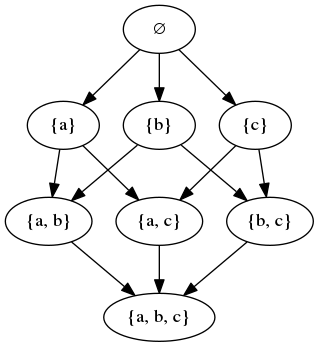Search for the optimal learning space from response patterns obtained from exam scores data.
NEAT algorithm is adapted to search for the best learning space with respect to observed response patterns in exam data. Proposed algorithm is evaluated and its performance is compared with IITA algorithm. Reconstruction simulation results can be found here.
python 3.5+, pip and git are required for installation.
Clone repository and install requirements
git clone https://github.com/nemanja-m/learning-space-generator.git
cd learning-space-generator
pip install -r requirements.txtRequirements should be installed under virtual env.
graphviz library is required to export learning space graph as PNG image.
On ubuntu based OS install graphviz with
sudo apt-get install grahvizCheck graphviz for more details.
Run tests with python -m pytest.
Run NEAT algorithm to find the optimal learning space with:
python -m lsg.run --generations=50 --parallelThis will start NEAT for 50 generations and parallel genome evaluation.
Run python -m lsg.run --help for help about available arguments.
Input is binary matrix of shape NxM where N is a number of response patterns, and
M is a number of items in domain. Check out sample dataset.
neat-python is used as a
library for NEAT algorithm. neat-python provides a configuration ini file
that is used to configure different parts of NEAT. Check neat-python
docs for more details about
neat-python configuration.
Configuration file with tweaked NEAT parameters contains
only parameters of interest for learning space generation.
[LearningSpaceGenome] section contains parameters that change behaviour of
learning space genome:
knowledge_items (int): number of knowledge items in observed response patternsmutation_prob (float): Probability that random knowledge state node will mutatemutation_sampling_dist (str: uniform or power): Probability distribution function that is used to select knowledge state node for mutation
Additional parameters like number of evolution generations or termination
fitness threshold are set via lsg.run CLI. Check python -m lsg.run --help for more
details.
Construction of learning spaces (or knowledge spaces) may be difficult to
manage because learning spaces are huge combinatorial structures and search
space is enormous. To find the optimal learning space with n knowledge items
(assessment questions), space of 2^n must be searched. In typical real-world
application n is 15+.
There are two main algorithm types for learning space construction:
- data driven, where learning space is derived from observed response patterns,
- domain expert querying, where domain expert answers some questions about domain to form adequate learning space.
To overcome problem with huge search space, NEAT algorithm is used to evolve the optimal learning space while preserving mathematical defined constrains (closure under union and presence of empty and full knowledge state).
Knowledge state is used as gene in NEAT genomes. Each knowledge state is
represented as bit array where i-th bit is 1 if i-th assessment question
is answered correctly or 0 otherwise. Bit array representation is useful for
fast operations related to knowledge items such as comparison, mutation etc.
Learning space is genome in NEAT algorithm. It is represented as set of genes (knowledge states). Mutation of learning space ensures that closure under union is satisfied. At the beginning of evolution, random population of learning spaces with two knowledge items (empty state and one random single item state) is created and evolved over provided number of generations.
Result of NEAT evolution is genome (learning space) with the best fitness score.
Fitness is defined as sum of genome size and discrepancy between given learning space and observed response patterns. This way, genomes with lower number of knowledge states is favored.
fitness = -(discrepancy + size)
Negative fitness is used because neat-python library maximizes fitness value.
Discrepancy is computational heavy and it is cached to provide significant speed-up.
During mutation, a random knowledge state (gene) from learning space (genome) is selected for mutation. Mutation consists of flipping a random bit in knowledge state. If mutated knowledge state is not present in learning space, it is added with any additional knowledge states to preserve closure under union.
Different gene selection strategies are implemented, where selecting random gene from uniform distribution provides the best results (it converges faster than other strategies).
Parallel evaluation uses all available CPU cores and it should be omitted for small learning spaces when number of knowledge items is less than 8 and number of genomes in population is under 500. In those situations, parallel evaluation introduces additional overhead for process creation and single global cache synchronization.
When number of knowledge items is greater than 8 and population size is in thousands, parallel evaluation provides significant speed-up.
The termination condition of a genetic algorithm (GA) is important in determining when a GA run will end. It has been observed that initially, the GA progresses very fast with better solutions coming in every few iterations, but this tends to saturate in the later stages where the improvements are very small.
Evolution process stops when:
- genome with perfect fitness (0 fitness) is found, or
- global best fitness score doesn't improve for t generations.
Parameter t indicates patience for fitness improvement and it can be set with
--patience or -t parameter when starting algorithm in lsg.run.
This project is available as open source under the terms of the MIT License.


